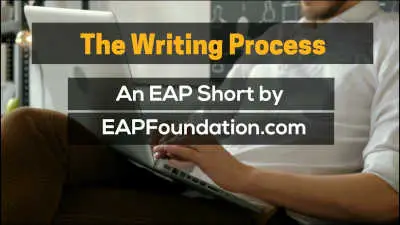Show AWL words on this page.
Show sorted lists of these words.


 







|
After you have written your first draft, the next stage of the writing process is to check your work. This page explains types of checking, what to check and how to check. There is also a checklist at the end of the page that you can use to peer edit or check your work.
Types of checking
There are different types of checking which can take place. The most authoritative type, of course, is for your tutor to check your work and give feedback. However, teachers do not always have the time to do this. Another resource for checking is your fellow students. These are your 'peers' (meaning 'equals') and this type of checking is called peer editing. A third and final type of checking is for you (the writer) to check the work yourself. Of course, if you are checking a short essay during an exam, only the final type is possible. It is better to get someone else (a teacher or peer) to check your work if possible, as they will be more objective, although there are also problems with this, especially peer checking, as peers are not usually very expert in this and may focus on the wrong areas (for example grammar instead of organisation).
What to check for?
A mistake many writers make when checking their work is to focus on the 'smaller' aspects such as grammar, spelling and punctuation. However, unless this is the final (or only) draft, these aspects are not important and should not be considered until the very end, when proofreading. At this stage of the writing process, you should be making sure that the content is strong, relevant and well organised.
As mentioned in the section on writing your first draft, you should have used double spacing and wide margins for easier editing, so this is something to check first, along with other formatting such as line breaks or indenting to show new paragraphs. It much easier to check something which is in paragraph rather than note form, so you should make sure your writing is in this form before checking begins. You should check the organisation by considering the thesis statement in the introduction (or the aim if it is a report) and summary in the conclusion, as well as topic sentences for each paragraph (or headings if it is a report). Good organisation also means putting the ideas in a logical order, and linking them in a coherent way, for example by using appropriate transition signals, so this is also something to look for. You should also consider the content, making sure there are strong supporting ideas, and making sure that all of the supporting ideas are relevant to the paragraphs, and that all paragraphs support the thesis (in other words, that there is unity). The introduction should begin with some background information, and there should be a final comment in the conclusion, so these are other areas to check. If it is a researched essay, you should also check that the in-text citations are accurate and appropriate, that the cited sources have been correctly paraphrased or that quotation marks "..." have been used, and that the reference section is accurate.
In short, you should consider all of the following.
- Format: double spacing, wide margins, etc.
- Organisation: thesis, topic sentences, logical order, coherence.
- Content: ideas, unity, background, final comment, citations.
How to check?
Whether you are reading your own work or checking for someone else, the general process is the same. You should proceed by reading through the writing carefully, remembering to focus on the aspects above. Try to use a checklist to help you focus (one is included at the end of this section). If there are parts which need to be rewritten or improved, try to make some notes in the margins or in the space on the line above (this is why double spacing and wide margins are important). For example, if some of the ideas are not strong enough, you can write down "add more details" or "be more specific". If there are some ideas which are not linked to the topic sentence, you should cross them out.
Checklist
Below is a checklist to help you or a peer check your written draft.
| Area | Item | OK? | Comments |
| Formatting | Is the formatting correct, e.g. double spacing, wide margins, line break or indenting to show a new paragraph? | ||
| Is the writing in paragraph (rather than note) form? | |||
| Organisation | Is there a clear thesis statement (for an essay) or aim (for a report)? Does the thesis show how the essay will be organised e.g. compare and contrast? | ||
| Does the conclusion have a summary or restatement of the thesis statement? | |||
| Is there a topic sentence for every paragraph? Does each topic sentence have a clear controlling idea? If it is a report, does it have clear headings? | |||
| Are the ideas in each paragraph arranged in a logical order? | |||
| Is there good coherence within paragraphs (via transition signals or pronouns) and between paragraphs (via transition signals or words/ideas repeated from the thesis)? | |||
| Content | Are there enough strong supporting ideas in each paragraph (examples, reasons, facts)? If it is a researched essay, are there enough (and not too many or too few) references to sources? | ||
| Do the paragraphs have unity, in other words, are all the ideas related to the topic sentence? Does the essay have unity, in other words, do all paragraphs relate to the thesis statement? | |||
| Does the essay begin with some background information on the topic? Does the conclusion end with a final comment, e.g. a recommendation? | |||
| Referencing (if contains sources) | Are the sources acknowledged correctly using in-text citations? | ||
| Are the sources correctly paraphrased or "quoted" to avoid plagiarism? | |||
| Are the reference section entries correct (format, details, alphabetical order)? |
References
Oshima, A. and Hogue, A. (1999) Writing Academic English. New York: Addison Wesley Longman.
University of Arizona (n.d.) The Structure of an Essay Draft. Available at: http://www.u.arizona.edu/~atinkham/Essay_Structure.htm (Access date 1/4/18).
Next section
Read about the next stage of the writing process, redrafting, in the next section.
Previous section
Read the previous article about writing the first draft.







